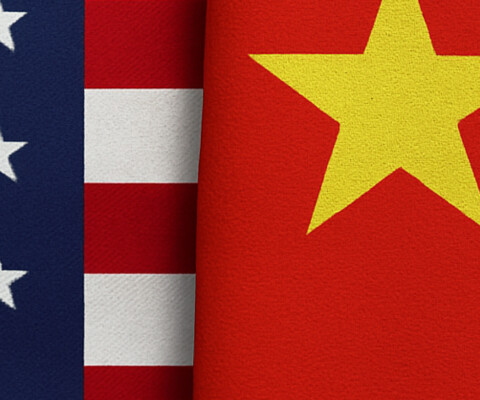In May 2025, the United States and China agreed to temporarily slash tariffs on each other’s goods following months of retaliation levies on one another.
As part of an agreed 90-day truce, the White House scaled back some of its heaviest barriers, dropping its main tariff on Chinese imports from 145% to 30%.
In return, China lowered its retaliatory tariffs on US goods from 125% to 10%.
For businesses moving goods across between the world’s two largest economies, this creates a brief but critical window to act.
In this article, we’ll discuss why moving now is essential, the impact we’ve already seen on shipping costs, and financial strategies your business can make to maximise earnings during this crucial period.
Table of contents
- Why this matters now
- What businesses need to consider now
- Conclusion: a window of opportunity, but not without risks
- 10 FAQs: US–China tariff truce and what it means for businesses
Why this matters now
With trade routes reopening and shipping volumes rising sharply, many businesses are racing to move inventory, restock supply chains, or renegotiate pricing terms while lower tariffs last.
Following the announcement on 12 May 2025, we’ve seen:
- Container volumes from China to the US surge 50%, according to Hapag-Lloyd.
- Freight rates jump from $2,000 to around $2,500 per container.
- Stock markets rally, with the Nasdaq up over 6% in the days following the trade truce.
- The DXY – a measurement used to show the value of the dollar against other major currencies – increased by 1.3% on the day of the announcement.
What businesses need to consider now
If you’re importing or exporting between the US and China, this 90-day window isn’t just a pause – it’s a chance to act decisively.
But taking advantage of the tariff relief requires rapid, well-informed decisions across in several areas of your business. Here are some key considerations:
Supply chain agility
A sudden 50% surge in China-to-US bookings signals two things: renewed demand and potential congestion. Whether you’re shipping finished goods or raw materials, consider:
- Can your suppliers increase output or speed up timelines?
- Do you have logistics partners ready to scale?
- Are you factoring in potential bottlenecks at ports, customs, or warehousing?
You may want to explore alternative ports or different modes of transport to avoid delays. Speed and flexibility are key while freight capacity is tightening.
Pricing and customer communication
The sudden drop in tariffs may improve your cost base, but only temporarily. Consider whether you can:
- Renegotiate with suppliers or buyers to reflect tariff reductions
- Pass on cost savings to stay competitive (or boost margins while you can)
- Communicate transparently with clients about potential pricing changes or availability
- Clear communication with international partners can build trust and help them plan more easily, too.
Financial forecasting and budgeting
Tariffs aren’t the only variable. Volatile exchange rates, rising freight costs, and global uncertainty all play a role. That’s why it’s vital to:
- Run scenario-based forecasts based on different tariff or FX outcomes
- Stress test budgets for a return to higher trade barriers
- Monitor exchange rates between USD, CNY, and your local currency to understand exposure
Strategic foresight now could shield your margins in Q3 and beyond.
Currency risk and payment solutions
With every tariff announcement creating volatility in the currency markets, we may see more movement in currencies like USD in the coming months.
Understanding the solutions you can use to control currency risk is critical to strengthen your business growth.
At Privalgo, we can help your business:
- Lock in favourable exchange rates during the 90-day window with forward contracts
- Set market orders to automatically execute when target rates are hit
- Use multi-currency accounts to hold USD and other currencies for conversion when the timing is right
- Streamline supplier payments with virtual IBANs for faster, easier reconciliation
Even minor currency movements can erode margins when trading at volume. Setting yourself a proactive FX strategy means you can move fast without overpaying.
Read: International payment costs: why they matter for businesses in 2025
Planning beyond the truce
This tariff pause is not a permanent solution, and both governments have made that clear.
As Washington and Beijing continue negotiations, it’s unclear whether tariffs will drop further, hold steady, or return to previous highs. This uncertainty makes it crucial to:
- Monitor political and economic signals closely
- Diversify sourcing and distribution channels (if not already doing so)
- Use this period to rebuild inventories or negotiate long-term trade agreements under current rates
- Stay in touch with advisors and partners who can help you act quickly when conditions change
Conclusion: a window of opportunity, but not without risks
The US–China tariff truce offers a short-term reduction in costs and a brief moment of clarity in an uncertain trade environment.
Businesses that act now can capitalise on lower tariffs and rising demand to improve their bottom line.
But this opportunity comes with its risks. Unpredictable currency movements can damage an otherwise optimistic window, and gaining control is paramount to protect your profits.
At Privalgo, we help importers, exporters, and global operators grow exponentially with our currency and payment solutions.
Contact our Currency Specialists today to learn how we can help your international business scale further, faster.
10 FAQs: US–China tariff truce and what it means for businesses
Below are 10 frequently asked questions about the US–China tariff truce and what it could mean for your business. Some questions are answered using content already discussed in this article.
What is the new trade deal with China?
In May 2025, the US and China agreed to a temporary 90-day suspension of certain tariffs. The US dropped its primary tariff on Chinese goods from 145% to 30%, and China lowered retaliatory tariffs on US goods from 125% to 10%. The truce is aimed at easing trade tensions while further negotiations take place.
How long will the tariff pause last?
The tariff suspension is currently set for 90 days from May 2025. Both sides have indicated that talks will continue, but there is no guarantee the reduced tariffs will remain in place after the truce expires.
Why is now a good time to move goods?
With tariffs lowered, shipping volumes from China to the US surged 50% in one week, according to Hapag-Lloyd. Businesses are moving fast to capitalise before tariffs potentially return. Freight rates are already rising due to increased demand.
How can I manage shipping delays during this surge?
To avoid disruption, businesses should:
- Secure space early with freight providers
- Explore alternative ports or air freight
- Build in extra lead time for customs and logistics coordination
What are the risks of not acting during the tariff window?
Delaying action could result in:
- Missed cost savings
- Difficulty sourcing space as demand peaks
- Exposure to potential tariff reintroduction after 90 days
How could exchange rates impact my costs?
Currency markets have already reacted, with the DXY dollar index rising 1.3% on 12 May 2025 If your costs or revenues involve USD or CNY, exchange rate volatility could significantly affect your margins.
Read: What is the FX spread and why does it matter your business?
What tools can help me control FX risk during this period?
FX tools like forward contracts and market orders allow you to:
- Lock in favourable rates
- Avoid overpaying if the market turns
- Automate trades at your target exchange rate
What if I don’t pay suppliers in USD or CNY?
Even if your invoices are in a different currency (like GBP or EUR), fluctuations in USD and CNY can still affect prices, lead times, and competitiveness. FX risk is often passed down the supply chain — and worth controlling proactively.
What happens after the 90-day truce?
Tariffs could remain reduced, be removed entirely, or return to previous highs depending on the outcome of trade talks. Businesses are encouraged to:
- Lock in costs now
- Diversify suppliers
- Review long-term supply contracts under current conditions
How can Privalgo help businesses respond to these changes?
At Privalgo, we offer:
- Live exchange rate visibility
- FX solutions like forward contracts and market orders
- Multi-currency accounts to hold and convert currencies strategically
- Virtual IBANs to streamline payments and reconciliation across markets
Our Currency Specialists work closely with your team to protect your margins and keep your global operations moving.
This article is for information purposes only and should not be regarded as financial advice.


